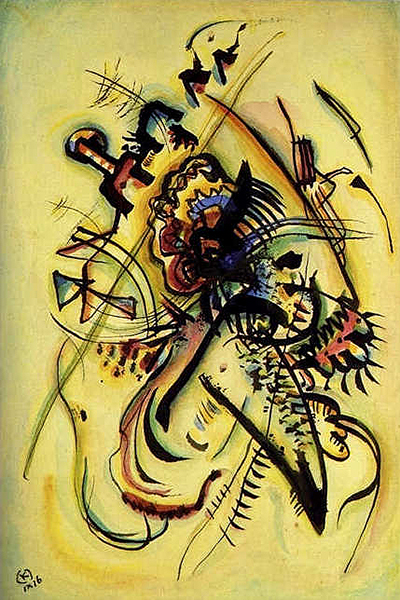This painting from 1916 was constructed by Wassily Kandinsky using watercolour and indian ink on a very small piece of paper, perhaps from a notebook or similar.
This was not an artist known particularly for his use of watercolours but during this decade he did make use of it from time to time. Colour was key to his work, and so there was no reason why he had to limit himself to the use of oil paints, although that format tended to provide him with the most vivid colours of all. There is also a speed to working with watercolours that offered a different consideration when planning each design. It may have been in this case that he wanted to work away from his studio and that a small selection of watercolours with a notepad was the most suitable option, and this has been the case with many other artists who have used both oils and watercolours at different stages in their career. You will note how the use of heavy black tones is present here, just as with other mediums, but the tones of other colours are perhaps not quite as bright.
Kandinsky experimented across the 1910s with different styles as well as different mediums, going beyond just the two standard painting choices. For example, he also produced woodcuts, lithographs and etching prints too, with the latter offering an opportunity to sell his designs to a wider audidence and help to expand his reputation across new boundaries. The actual content of To the Unknown Voice is entirely consistent with this artist's work, with long lines and abstract shapes combining to produce a dreamlike world that beared little connection to reality. He signed it with a simple letter K in the bottom left corner, along with the date.
The title of this piece refers to how he constructed the work shortly after chatting on the phone to Nina Andreevskaya, who at the time was a relative stranger. They would later become married and so this piece offers an exciting abstract look into their early relationship. Whilst one might not immediately cite romance as an inspiration for this work, when first viewing it, many have argued that certain elements of it lean towards that suggestion. It can now be found in the collection of the Guggenheim in New York, alongside a good number of other artworks from this artist. You can also learn more about the artist's life in our biography here.




